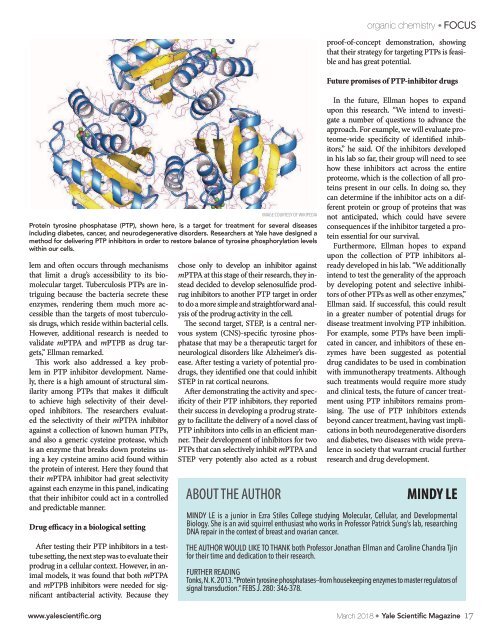YSM Issue 91.1
You also want an ePaper? Increase the reach of your titles
YUMPU automatically turns print PDFs into web optimized ePapers that Google loves.
organic chemistry<br />
FOCUS<br />
lem and often occurs through mechanisms<br />
that limit a drug’s accessibility to its biomolecular<br />
target. Tuberculosis PTPs are intriguing<br />
because the bacteria secrete these<br />
enzymes, rendering them much more accessible<br />
than the targets of most tuberculosis<br />
drugs, which reside within bacterial cells.<br />
However, additional research is needed to<br />
validate mPTPA and mPTPB as drug targets,”<br />
Ellman remarked.<br />
This work also addressed a key problem<br />
in PTP inhibitor development. Namely,<br />
there is a high amount of structural similarity<br />
among PTPs that makes it difficult<br />
to achieve high selectivity of their developed<br />
inhibitors. The researchers evaluated<br />
the selectivity of their mPTPA inhibitor<br />
against a collection of known human PTPs,<br />
and also a generic cysteine protease, which<br />
is an enzyme that breaks down proteins using<br />
a key cysteine amino acid found within<br />
the protein of interest. Here they found that<br />
their mPTPA inhibitor had great selectivity<br />
against each enzyme in this panel, indicating<br />
that their inhibitor could act in a controlled<br />
and predictable manner.<br />
Drug efficacy in a biological setting<br />
After testing their PTP inhibitors in a testtube<br />
setting, the next step was to evaluate their<br />
prodrug in a cellular context. However, in animal<br />
models, it was found that both mPTPA<br />
and mPTPB inhibitors were needed for significant<br />
antibacterial activity. Because they<br />
chose only to develop an inhibitor against<br />
mPTPA at this stage of their research, they instead<br />
decided to develop selenosulfide prodrug<br />
inhibitors to another PTP target in order<br />
to do a more simple and straightforward analysis<br />
of the prodrug activity in the cell.<br />
The second target, STEP, is a central nervous<br />
system (CNS)-specific tyrosine phosphatase<br />
that may be a therapeutic target for<br />
neurological disorders like Alzheimer’s disease.<br />
After testing a variety of potential prodrugs,<br />
they identified one that could inhibit<br />
STEP in rat cortical neurons.<br />
After demonstrating the activity and specificity<br />
of their PTP inhibitors, they reported<br />
their success in developing a prodrug strategy<br />
to facilitate the delivery of a novel class of<br />
PTP inhibitors into cells in an efficient manner.<br />
Their development of inhibitors for two<br />
PTPs that can selectively inhibit mPTPA and<br />
STEP very potently also acted as a robust<br />
ABOUT THE AUTHOR<br />
IMAGE COURTESY OF WIKIPEDIA<br />
Protein tyrosine phosphatase (PTP), shown here, is a target for treatment for several diseases<br />
including diabetes, cancer, and neurodegenerative disorders. Researchers at Yale have designed a<br />
method for delivering PTP inhibitors in order to restore balance of tyrosine phosphorylation levels<br />
within our cells.<br />
proof-of-concept demonstration, showing<br />
that their strategy for targeting PTPs is feasible<br />
and has great potential.<br />
Future promises of PTP-inhibitor drugs<br />
In the future, Ellman hopes to expand<br />
upon this research. “We intend to investigate<br />
a number of questions to advance the<br />
approach. For example, we will evaluate proteome-wide<br />
specificity of identified inhibitors,”<br />
he said. Of the inhibitors developed<br />
in his lab so far, their group will need to see<br />
how these inhibitors act across the entire<br />
proteome, which is the collection of all proteins<br />
present in our cells. In doing so, they<br />
can determine if the inhibitor acts on a different<br />
protein or group of proteins that was<br />
not anticipated, which could have severe<br />
consequences if the inhibitor targeted a protein<br />
essential for our survival.<br />
Furthermore, Ellman hopes to expand<br />
upon the collection of PTP inhibitors already<br />
developed in his lab. “We additionally<br />
intend to test the generality of the approach<br />
by developing potent and selective inhibitors<br />
of other PTPs as well as other enzymes,”<br />
Ellman said. If successful, this could result<br />
in a greater number of potential drugs for<br />
disease treatment involving PTP inhibition.<br />
For example, some PTPs have been implicated<br />
in cancer, and inhibitors of these enzymes<br />
have been suggested as potential<br />
drug candidates to be used in combination<br />
with immunotherapy treatments. Although<br />
such treatments would require more study<br />
and clinical tests, the future of cancer treatment<br />
using PTP inhibitors remains promising.<br />
The use of PTP inhibitors extends<br />
beyond cancer treatment, having vast implications<br />
in both neurodegenerative disorders<br />
and diabetes, two diseases with wide prevalence<br />
in society that warrant crucial further<br />
research and drug development.<br />
MINDY LE<br />
MINDY LE is a junior in Ezra Stiles College studying Molecular, Cellular, and Developmental<br />
Biology. She is an avid squirrel enthusiast who works in Professor Patrick Sung’s lab, researching<br />
DNA repair in the context of breast and ovarian cancer.<br />
THE AUTHOR WOULD LIKE TO THANK both Professor Jonathan Ellman and Caroline Chandra Tjin<br />
for their time and dedication to their research.<br />
FURTHER READING<br />
Tonks, N. K. 2013. “Protein tyrosine phosphatases--from housekeeping enzymes to master regulators of<br />
signal transduction.” FEBS J. 280: 346-378.<br />
www.yalescientific.org<br />
March 2018<br />
Yale Scientific Magazine<br />
17


















